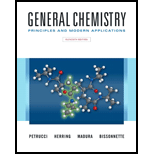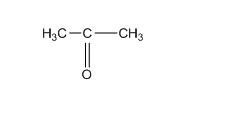
Concept explainers
(a)
Interpretation:
Corresponding range of wavelength and frequencies should be calculated for given wavenumbers.
Concept introduction:
(b)
Interpretation:
The bonds responsible for the absorptions labeled A, B, C, and D in the two infrared spectrashown here should be identified.
One spectrum is for acetone and the other spectrum is for 1-propanol, both of which are colorless liquids. From the two spectra, the spectra of acetone should be determined.
Concept introduction:
Acetone; - has one C=O bond, 2 C-C bonds, 6 C-H bonds.

1-propanol; - has one C-O bond, 2 C-C bonds, 7 C-H bonds and one O-H bond.

(c)
Interpretation:
The structure of the compound should be determined on the basis of given information:
Want to see the full answer?
Check out a sample textbook solution
Chapter 26 Solutions
GENERAL CHEMISTRY-MOD.MASTERINGCHEM.
- Select the bonds in the 3D representation of methyl urethane below that are multiple bonds. (Hint: Consider the number of bonds attached to an atom in the image compared to the normal valence of that atom. In a valid structure, the number of bonds to an atom will equal the valence of that atom.) • Gray = C: white = H; red = 0; blue = N; dark green = Cl; brown = Br; light green = F; purple = 1; yellow = S: orange = P. • Double click to select bonds. You can zoom in and out using the mouse scroll wheel (or pinch to zoom on touch screens). ●arrow_forwardFill out the table with correct answers. This is all about Hydrocarbons and Functional Groups Chemistry. The most interesting Functional Group Why is it more interesting than other Functional Group(Ethers, Aldehydes and ketones, carboxylic acids,esters and amines) Give a sample structure of your chosen functional compound Give its Special Properties and Common Uses Name Products or things in which this Functional Group is present Alcohols-(R-OH; R=hydrocarbon)arrow_forwardA. Structural Isomerism of Alkanes, continued. Construct models for the five alkanes that have the molecular formula C6H₁4. All five of your models should have the same number of each type of atom, but they should have the atoms connected in a different order. Thus the molecules they represent are structural isomers of one another. Note the tetrahedral geometry of each carbon atom. Draw an extended and a condensed structure (NOT skeletal/line angle) of each structural isomer, then determine its IUPAC name. Recall that since the IUPAC name specifies the number of each type of atom and how they are connected, each structural isomer will have a different name. Each name should very specifically describe the structure. Isomer 3: Extended Structure Isomer 3: Condensed Structure IUPAC Name: IUPAC Name: Isomer 4: Extended Structure Isomer 4: Condensed Structurearrow_forward
- 1A1: Integrate existing knowledge of ionic/covalent bonding, lone pairs, formal charge, valence, and Lewis structures to generate chemically-correct organic building blocks. Examine the given line-angle structure and redraw it, correcting all errors of structure (bonding, lone pairs, formal charge, valence, and the octet rule). 14 H3C. CI- H3C CH3 O H3C B-CH3 N-CH3 CH3arrow_forwardWe see that 1-propanol and 2-propanol have the same molecular formula, C3H7OH, but different molecular structures. What is the name for molecules that have the same molecular formula but different structural formulas (different shapes)? Use the specific term.arrow_forwardAromatic compounds got their name because many have strong smells. Benzene, toluene, aniline, and phenol are common structures from which most aromatic compounds are derived. (Figure 1) When naming aromatic compounds with three or more substituents, the ring is numbered to give the smallest possible set of numbers. For example, this phenol derivative (Figure 2) is called 4-bromo-3-chlorophenol. The substituents Figure CH3 NH₂ 1 of 2 > OH benzene toluene aniline phenol Name the following molecule by its IUPAC name. ► View Available Hint(s) Submit Part B Name the following molecule by its IUPAC name. CI Br CH3 CI Brarrow_forward
- complete a Carvone Lewis structure that displays all valence electrons, all atoms and all the formal charges, if any. Use only a single dash for each pair of bonding electrons and a pair of dots for all nonbonding pairs of electrons. Identify and label all functional groups (alcohols, amines, amides, carboxylic acids, ketones, aldehydes, aromatic rings, aromatic amines, etc) on the Lewis Structure. You do not have to circle alkanes. (Must be included in the preliminary submission and in the PowerPoint.)arrow_forwardIn an advanced analytical chemistry lab, a team analyzing a compound 'Q' known to be a structural isomer of octane (C8H18). To determine the specific structure of 'Q', a series of spectroscopic analyses are performed. The sequence of the analysis involves: Infrared (IR) spectroscopy, which indicates the absence of functional groups like alcohols, ketones, and carboxylic acids. Nuclear Magnetic Resonance (NMR) spectroscopy, showing signals indicative of only methyl and methylene groups, with no evidence of methine (CH) or quaternary carbon environments. Mass spectrometry (MS), revealing a fragmentation pattern consistent with branched alkane structures. Based on this sequence of analyses, what is the most likely structure of compound 'Q'? Options: A. 2,2,4- Trimethylpentane B. n-Octane C. 2-Methylheptane D. 3-Ethylhexane Don't use chatgpt please provide valuable answerarrow_forward1. Organic chemistry is most broadly defined as the chemistry of many compounds of carbon the chemistry of living systems the chemistry of the nonmetallic compounds the chemistry of substances produced by living systems. 2. An organic compound is best defined as carbon atoms covalently bonded to hydrogen atoms a compound containing carbon. a compound that is NOT produced in the laboratory. a compound produced an organism. 3. The simplest alkane is methane propane ethane monalkane Would like to know if my answers are correct. Bullet points in bold. thx :)arrow_forward
- What is Resonance Theory? Sate five conclusions that can be drawn from the theory. State the two main experiments that were used to establish the extra stability of the benzene molecule. What are the factors that confer Aromaticity to an organic molecule?arrow_forwardA. Structural Isomerism of Alkanes Construct models for the five alkanes that have the molecular formula C6H14. All five of your models should have the same number of each type of atom, but they should have the atoms connected in a different order. Thus the molecules they represent are structural isomers of one another. Note the tetrahedral geometry of each carbon atom. Draw an extended and a condensed structure (NOT skeletal/line angle) of each structural isomer, then determine its IUPAC name. Recall that since the IUPAC name specifies the number of each type of atom and how they are connected, each structural isomer will have a different name. Each name should very specifically describe the structure. Isomer 1: Extended Structure Isomer 1: Condensed Structure IUPAC Name: IUPAC Name: Isomer 2: Extended Structure Isomer 2: Condensed Structurearrow_forwardWhat is the importance of functional groups in organic chemistry and how does it affect the entire molecule?arrow_forward
- Chemistry: Matter and ChangeChemistryISBN:9780078746376Author:Dinah Zike, Laurel Dingrando, Nicholas Hainen, Cheryl WistromPublisher:Glencoe/McGraw-Hill School Pub Co
